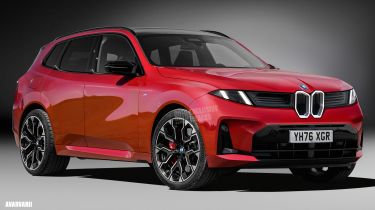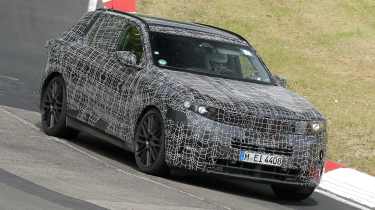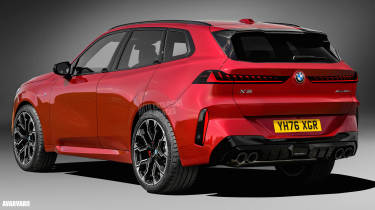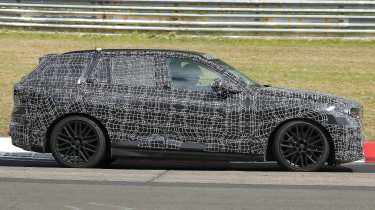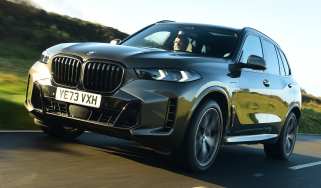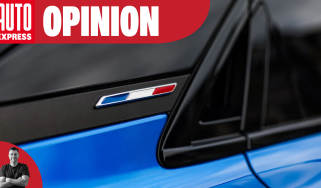New BMW X5 SUV: design, tech and engine options
The new BMW X5 will use petrol, hybrid and even hydrogen power, and is set to arrive next year
A new BMW X5 is in the works and is set to arrive in 2026 to take on rivals including the Audi Q7, Porsche Cayenne and Range Rover Sport. Few official details have been revealed yet, but our exclusive images preview how it could look.
BMW has confirmed that the new X5 will be available with hydrogen power, likely in addition to the expected combustion-only, plug-in hybrid and electric models. Expect the X5 name to be used for the versions that have a petrol or diesel engine, and iX5 for the ones that use electric power only, including the hydrogen model.
The BMW iX5 Hydrogen will arrive after the regular versions and is a result of BMW’s long-running research into the fuel. Like previous hydrogen models, such as the Toyota Mirai, it will use an electric motor with a small battery charged using a hydrogen fuel cell, emitting nothing but water in the energy-production process.
Four-wheel drive, which BMW calls xDrive, is likely to be standard across the range, and the large SUV will feature a luxurious, hi-tech interior with more features than the current car. Since BMW hasn’t revealed official details yet, we can only speculate on what the new model will offer.
However we’ve seen the car out on the road already via our spy photographers, including some of it undergoing high-speed testing at the Nurburgring race track in Germany. High-performance versions have become a staple in the brand’s SUV range and the new X5 should be no exception.
BMW will soon reveal its Neue Klasse models, which include a new iX3 and 3 Series saloon. We expect that the new X5 will have its own reveal following that, likely in mid-2026 for a launch at the end of that year or early in 2027.
While the next 3 Series saloon will use a new platform, we expect the BMW X5 to continue with the existing CLAR architecture for the upcoming version. That means we have some idea of what kind of powertrains it will use, so read on to find out more about that plus more on running costs, design and cost.
What powertrain options will the new BMW X5 have?
While the outgoing BMW X5 isn’t offered as an EV, we know the underpinnings support this tech; the current 5 Series is available with petrol, PHEV and electric powertrains, and the X5 is expected to follow suit.
Despite BMW largely phasing out diesel in its UK line-up, we expect the X5 to still be offered with its venerable 30d and 40d powertrains. A spokesperson said the maker has a “technologically open” approach to engines, and that “if the market wants diesel, [BMW] can provide it”. While the 5 Series doesn’t get a diesel engine in the UK, the latest X3 does – and the X5’s bigger bodystyle should see it follow its SUV sibling.
When it comes to petrol engines, the sheer size will probably discount the use of four-cylinder power, with the base 40i using a six-cylinder layout with mild-hybrid assistance. A faster X5 M60i should be available soon after launch, with an X5 M coming later down the line – probably with the twin-turbo V8 plug-in hybrid powertrain from the M5.
Speaking of plug-in hybrid power, we can safely assume that the new X5 xDrive50e will lift the BMW 550e’s 449bhp petrol-electric powertrain completely unchanged. This should give the PHEV enough shove for 0-62mph in around 4.5 seconds.
Then there’s the EVs, which will probably be badged iX5. Again, using the i5 as a base, we can expect a base eDrive40 model, bolstered by a faster iX5 M60. With around 335bhp, the cheaper of the two EVs will cover 0-62mph in just over six seconds, with the near-600bhp M60 slashing that to around four seconds flat. Expect plenty of trick chassis and suspension tech to keep the car’s inevitable mass in check.
The BMW iX5 Hydrogen will arrive after the rest of the X5 range and uses a fuel cell to produce power using liquid hydrogen. Poor infrastructure here in the UK will be a limiting factor but the fuel type is promising in bringing low emissions while maintaining quick fill-ups – there’s no waiting for a battery to charge because the energy is produced using fuel in the car.
What do we know about the efficiency and running costs?
The X5 is set to be bigger than ever, so it’s not going to win any prizes for fuel economy or emissions. That said, by fitting at least mild-hybrid tech to all engines, we can expect competitive running costs across the board.
The diesels will be best for those covering big distances or towing trailers, but the long-range PHEVs should allow the new X5 xDrive50e to cover at least 50 miles without using a drop of fuel – possibly more if the firm finds a way of squeezing a slightly larger battery under the floor. For context, the 550e uses a 22.1kWh battery, for up to 62 miles of range.
The EVs will be more susceptible to the increased weight, yet given the i5 eDrive40 fitted with an 81.2kWh battery claims a maximum 357 miles of range, the larger, heavier X5 should comfortably exceed 300 miles on a charge. The more powerful M60 won’t go as far, but 250 miles should be possible as a bare minimum.
What is the BMW X5’s exterior and interior design like?
We’ve caught the new BMW X5 undergoing testing on three separate occasions now. Once on European roads last summer, once during the winter up near the arctic circle, and most recently at the Nurburgring race track in Germany.
It means, with a little artistic licence, we can confidently peel back the camouflage for an accurate representation of what the firm’s next-generation SUV might look like – shown here by our exclusive images. The Neue Klasse-inspired front end is a given, with the two-prong daytime running lights giving the model a distinct signature at night.
The slim, upright kidney grilles will be an SUV styling trait going forward – we expect to see them first on the iX3 due for reveal at the Munich Motor Show in September – while the black panel that flanks them is expected to house a variety of cameras and sensors for the car’s myriad driver-assistance systems.
Overall, we can expect the X5 to adopt a more dynamic profile than before. BMW will employ clever optical trickery to disguise the car’s bulk – things like a wider track will help lower the roofline, at least visually, while a sloping back end should aid aerodynamics.
Big wheels and muscular haunches are all but a given, though note the lack of conventional door handles – as confirmed in the most recent spy pictures. Instead, the X5 will use tabs at the base of the B and C-pillars, much like you’ll find on a Ford Mustang Mach-E.
We expect the rear of the car to also be inspired by the forthcoming iX3 and 3 Series, featuring a lightbar-like design split by a central BMW badge. Placing the number plate on the bumper allows for a low load lip, which should help practicality and ease of access to the large boot and rearmost seats.
We haven’t had much of a look inside, but we know that every new BMW will use the firm’s Panoramic iDrive infotainment system (more on that below) with a main screen complimented by a panel that runs along the base of the windscreen, spanning the entire width of the dashboard.
Otherwise, expect all the usual high-end materials and Veganza leather alternatives for the seats, dash and doors, plus tech extras such as upgraded stereos and a widescreen head-up display. Heated seats, steering wheels and even cupholders are likely to feature, too.
What do we know about the infotainment system?
Panoramic iDrive will define BMW’s cabin architecture for every future model, starting with the upcoming iX3. The set-up will be expanded to fit the slightly wider X5, with a shallow screen running the width of the dash showing everything from speed, trip and range information directly ahead of the driver, to media and phone connectivity in the centre.
It’ll feature customisable widgets, and will be complimented by a large lower touchscreen, functioning as a conventional display and housing things like wireless Apple CarPlay and Android Auto. BMW has confirmed it will not offer CarPlay Ultra on any of its models.
We don’t expect BMW’s lauded rotary iDrive controller to feature in the new X5. Joern Freyer, vice president of user experience development at BMW, previously told us that usage of the console-mounted dial “dropped year by year” – largely due to the number of touch functions that the systems now employ.
How practical is the new BMW X5 and how big is the boot space?
While we’ve not yet had a chance to get up close and personal with the new X5, it’s all but certain to grow slightly over the outgoing model. The CLAR platform is scalable, but we know the i5 saloon and i5 Touring estate both measure just over five metres nose to tail – around 125mm longer than the existing, seven-seat X5.
By lengthening the wheelbase – possibly beyond three metres – the designers and engineers will open up more space inside the SUV, while also improving comfort over rough roads. As mentioned, however, it’s unlikely BMW will want to sacrifice anything when it comes to agility and handling; the implementation of trick technology and next-generation damping will play a big part here.
What safety tech does the new BMW X5 have?
The X5 will carry the mantle of being BMW’s most technologically advanced model until the all-new X7 arrives some time in 2027.
That means it’ll be fitted with a suite of driver-assistance systems including semi-autonomous driving functions and the latest crash-avoidance tech. Expect it to be heavily integrated into the Panoramic iDrive layout, as well as the car’s head-up display.
How much will the new BMW X5 cost?
We’re still a long way away from BMW announcing the prices for the next-gen BMW X5.
Given the fact the current car starts from £74,280, it’s highly likely the new car will start from well over £80k, even in its most basic form and will likely exceed the £100k mark for the top-spec version. That would place the X5 in a similar ballpark to rivals that include the Range Rover Sport and Audi Q7. Huge savings can be found on both through our Buy A Car service, with almost £7,000 off a new Range Rover Sport and almost £9,000 off a new Audi Q7.
When will the new BMW X5 go on sale?
BMW has told us that it is gearing up to reveal the car towards the middle of 2026, with the start of sales and delivery of customer cars due roughly six months later at the start of 2027.
The X5 is one of 40 new or revised BMWs set to be revealed by the end of 2027.
When will the Neue Klasse BMWs arrive?
iX3 (Due: September)
The forthcoming iX3 will be revealed in September and will launch the firm’s ‘Neue Klasse’ styling language, set to feature on 40 new or revised BMWs before the end of 2027. This will separate it from the existing X3, while also ushering in the firm’s exciting new Panoramic iDrive infotainment system.
3 Series (Due: mid-2026)
Next up is the replacement for the big-selling 3 Series. It’ll be closely related to the iX3, with the same platform and powertrain tech, plus a similarly bold look. BMW will offer the new 3 with combustion engines and EV powertrains, setting new benchmarks for efficiency and range.
X5 (Due: mid/late-2026)
Unlike the smaller 3 Series and iX3, the new X5 will sit on the same platform as the old car, but with heavily updated tech. Powertrain options will include everything from petrol, diesel and hybrid, to EV and even – in some markets – a hydrogen fuel cell. Big interior updates will also feature.
5 Series LCI (Due: 2027)
The 5 Series only went on sale in 2023, so its facelift – or life-cycle impulse (LCI) in BMW speak – is still a little way off. Unlike most mid-life updates, the 5 Series is set to get a completely new look to pull it in line with the other Neue Klasse models; expect significant changes on the outside, plus a completely new interior.
X7 (Due: 2027)
The X5 will act as BMW’s tech flagship until its range-topping X7 arrives in 2027. By using the smaller SUV as a base, the X7 will finally be offered with plug-in and all-electric powertrains – something it has so far done without. And of course, it’ll look just like the other cars listed here, with a Neue Klasse face and fresh cabin layout.
Want the latest car news in your inbox? Sign up to the free Auto Express email newsletter...
Find a car with the experts
